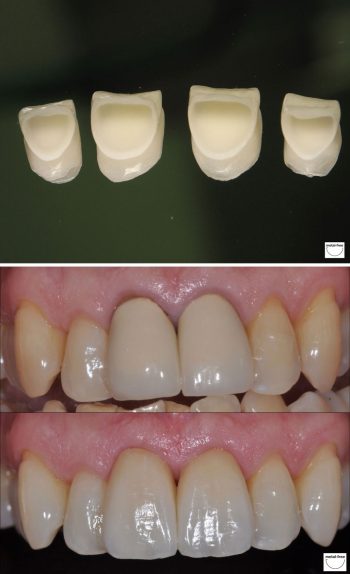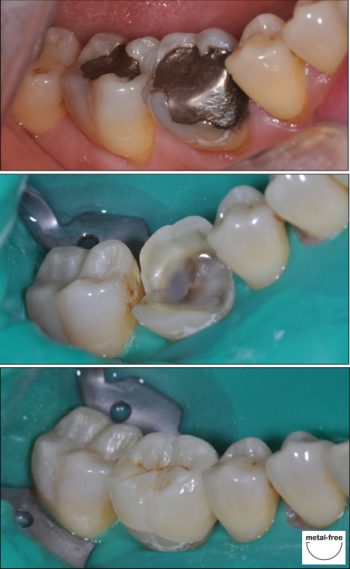metal free restoration

Metal Free Fillings
There are 2 types of metal free fillings materials we routinely use, Biodentine and composites.
Biodentine is a tricalcium silicate-based material . It is biocompatible and bioactive material. Biodentine is used as “lining” under a filling. It chemically bonds to the tooth and can help to remineralise decayed teeth by releasing Fluoride directly into the tooth.
We understand some people have concerns regarding Fluoride. We agree that ingesting Fluoride can affect the gut biome, which is essential for health. However, from our understanding, the levels released from Biodentine are not harmful, and we feel the benefits far outweigh the concerns. We also have a situation where we have to use something to restore a tooth, and out of all the current materials, we feel biodentine and some composites are the safest. When used with a disinfection and remineralisation protocol, we reduce the number of teeth that need to be root treated or removed
Composite materials are resins which are filled with a ceramic or glass particles. They are either a paste or flowable materials which are set by a special light.
Composites require the use of a bonding agent (glue) to stick them to the tooth.
Before we place the composite, we remove the old restoration and decay.
In deep cavities, we use Biodentine as a lining material to reduce the chance of injury to the nerve and to help remineralise any remaining
decay.
A bonding agent is applied to improve the bond strength and the cavity is restored with a composite material. Composite fillings are very technique sensitive and requires time to do well.
Studies have shown that the bond between the tooth and the composite can break down over time. Some people suggest composite restorations should be replaced after 5 to 8 years.
We feel with modern materials and good techniques they can last much longer. We use a variety of composite brands, depending on what we are trying to achieve. In general, the composites we use are considered biocompatible.
Universal nano-hybrid ORMOCER restorative material
Mercury fillings may continually release mercury vapour after they’ve been placed, despite being branded as ‘stable’. However, the BPA compound released from a composite isn’t something which continues after its initial placement. Research shows the highest BPA release comes just after the composite has been put in the tooth, with no detectable traces found in a patient’s saliva after the first 24 hours.
The human body can remove BPA as long as exposure to it doesn’t continue. Despite concerns about its effect on people’s health and the environment, it’s still widely used today. This means exposure the BPA on a daily basis is often much higher than the one-off contact of receiving a composite filling

Metal Free Crowns
We believe porcelain and zirconia crowns are not only superior in terms of biocompatibility, but they are also far superior cosmetically too.
The gum health around all porcelain and zirconia crowns is generally much better than a metal-containing crown. With modern materials, the tooth reduction is less than compared to a porcelain bonded to a metal support crown.
What’s involved?
If a tooth already has a crown, we will safely remove it .
If a tooth is extensively broken down, it may be impossible to restore it back to health with just a filling. In these situations, a laboratory made crown or inlay/onlay may be recommended.
Any decay is removed from the tooth, and the tooth is built up and strengthened with composite or glass ionomer (“core build”).
The tooth is shaped and polished, and an impression or scan is made, which is sent to the laboratory for a crown to be made.
A temporary crown is placed onto the tooth between visits.
Metal free Inlays and Onlays
Porcelain can be used as a filling material instead of composite. This type of restoration is called a inlay/onlay and is made by a dental technician. The restorations are stronger and last longer than composite fillings.
We may recommend this when a tooth is cracked or has a very large filling, but doesn’t require a crown.


Metal free Bridges
A dental bridge can be used to replace one or more missing teeth.
It consists of one or more artificial teeth (called pontics) that are supported by neighbouring natural teeth or dental implants. The natural teeth or implants on either side of the gap serve as anchors for the bridge.
A Dental bridge can be made from Porcelain or Zirconia. They are custom-made to match the colour, shape, and size of the surrounding natural teeth, providing a natural appearance.
A dental bridge not only restores the appearance of a complete smile but also helps to improve chewing and speaking abilities, maintain facial structure, prevent remaining teeth from shifting out of position, and distribute biting forces evenly across the dental arch.
